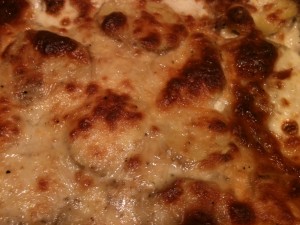Ingredients:
Â
- 1 1/2 lbs thickly sliced yellow onions, a sweet variety if possible (about 6 cups)
- 1/2 cup mild-tasting olive oil
- 6 garlic cloves, thinly sliced
- salt
- 1 lb green swiss chard, thick ribs removed and cut into 1-inch-wide ribbons
- water, as needed
- 10 ounces day-old chewy peasant-style bread, cut into rough 1-inch cubes (8 to 10 cups)
- 3 -4 cups chicken stock (or another flavourful stock) or 3 -4 cups vegetable stock (or another flavourful stock)
- 6 ounces fontina (a combination works well) or 6 ounces gruyere (a combination works well) or 6 ounces another melting cheese, coarsely grated (a combination works well)Change Measurements: US | Metric
Directions:
 Prep Time: 30 mins
Total Time: 2 1/2 hrs
- 1 To prepare onions: Place the onions in a deep saucepan (or Dutch oven) and drizzle and toss with oil to coat, about 1/4 cup. Set over medium-high heat and, shimmying the pan occasionally, cook until the bottom layer of onions is slightly golden around the edges, about 3 minutes. Stir and repeat. Once the second layer of onions has colored, reduce heat to low and stir in garlic and a few pinches of salt. Stew, stirring occasionally, until the onions are a pale amber and tender but not mushy, about another 20 minutes. If at any point the onions dry, cover them to trap some moisture.
- 2 Preheat the oven to 325°F.
- 3 To prepare chard: Place a few handfuls of leaves in a large saute pan or skillet with a drizzle of oil, a sprinkling of water (if you’ve just washed the chard, it may have enough on the leaves), and a few pinches of salt. Set the pan over medium heat until the water begins to steam, then reduce the heat and stir and fold leaves until just wilted, 3 to 4 minutes. (Leaves should be uniformly bright green, the white veins pliable.
- 4 To prepare bread: Toss and massage the cubed bread with a few tablespoons of olive oil, a generous 1/4 cup of the stock and a few pinches of salt, to taste.
- 5 To prepare panade: Use a flameproof, 3-quart souffle dish or enameled cast-iron Dutch oven. Assemble the panade in layers, starting with a generous smear of onions, followed by a loose mosaic of bread cubes, a second layer of onions, a wrinkled blanket of chard, and a handful of the cheese. Repeat, starting with bread, the onions and so on, until the dish is brimming. Aim for 2 to 3 layers of each component, then make sure the top layer displays a little of everything. Irregularity in the layers makes the final product more interesting and lovely. Drizzle with any remaining olive oil.
- 6 Bring the remaining 3 3/4 cups stock to a simmer and taste for salt. Add stock slowly, in doses, around the edge of the dish. For a very juicy, soft panade, best served on its own, like a soup or risotto, add stock nearly to the rim; for a firm but succulent panade, nice as a side dish, fill to about 1 inch below the rim. Wait a minute for stock to be absorbed, then add more to return to the desired depth. The panade may rise a little as the bread swells.
- 7 Set panade over low heat and bring to a simmer; look for bubbles around the edges (heating it here saves at least 30 minutes of oven time).
- 8 Cover the top of the panade with parchment paper, then very loosely wrap the top and sides with foil. Place a separate sheet of foil under the panade or on the rack below it, to catch drips.
- 9 Bake until the panade is piping hot and bubbly. It will rise a little, lifting the foil with it. The top should be pale golden in the center and slightly darker on the edges. This usually takes about 1 1/2 hours, but varies according to shape and material of baking dish and oven.
- 10 Browning and serving: Uncover panade, raise temperature to 375°F, and leave until golden brown on top, 10 to 20 minutes. Slide a knife down the side of the dish and check the consistency of the panade. Beneath the crust, it should be very satiny and it should ooze liquid as you press against it with the blade of the knife. If it seems dry, add a few tablespoons simmering stock and bake for 10 more minutes.
Â





